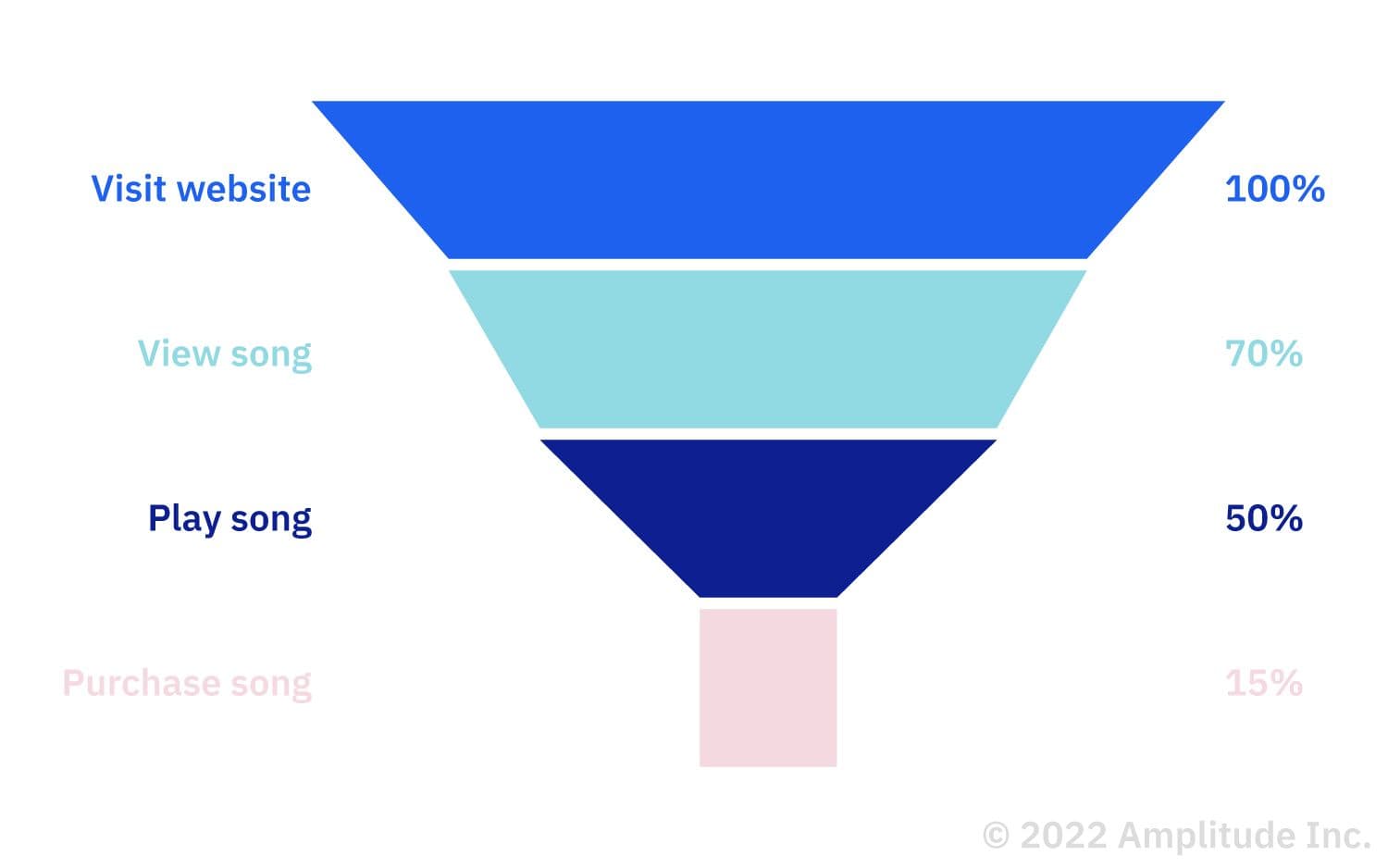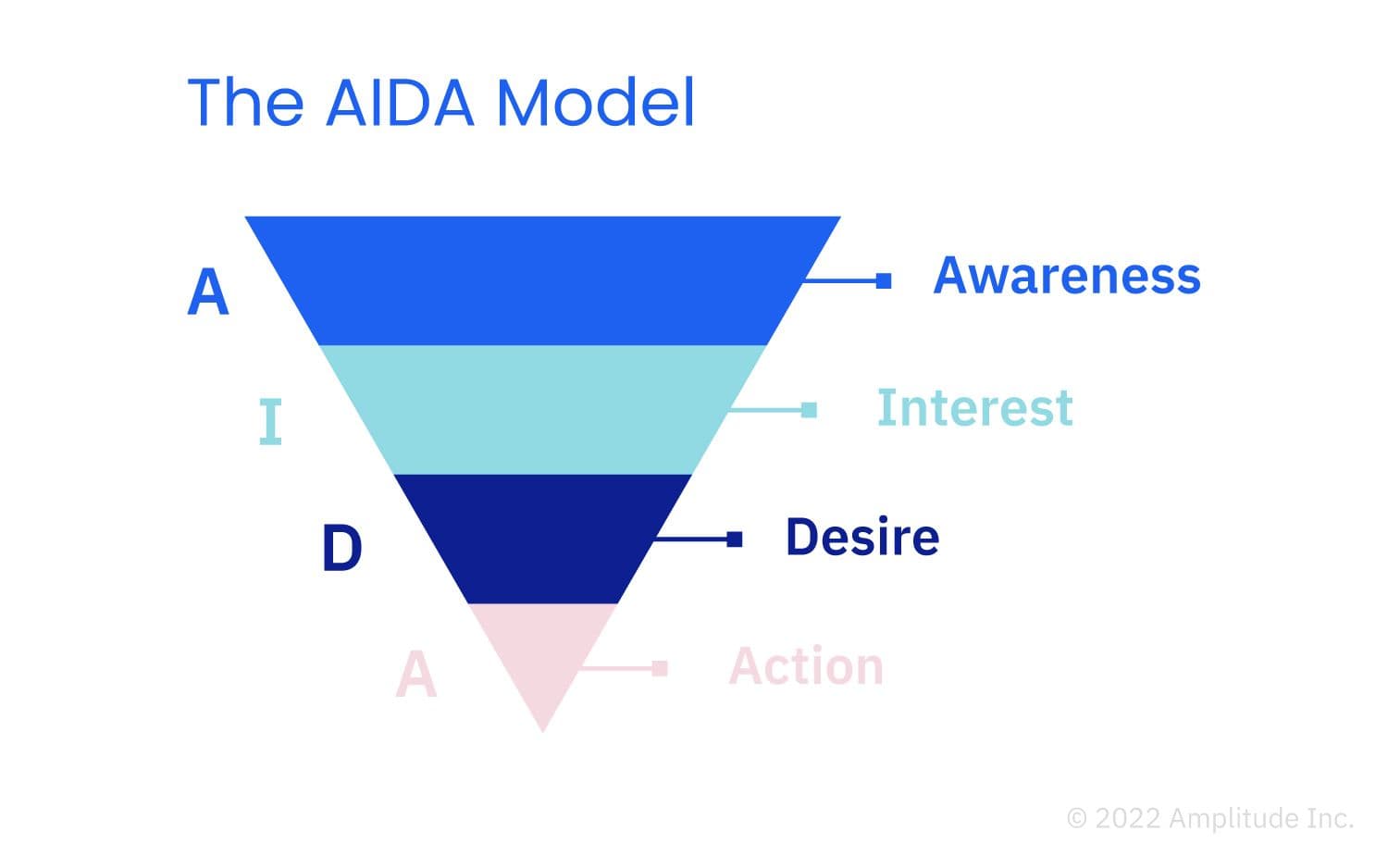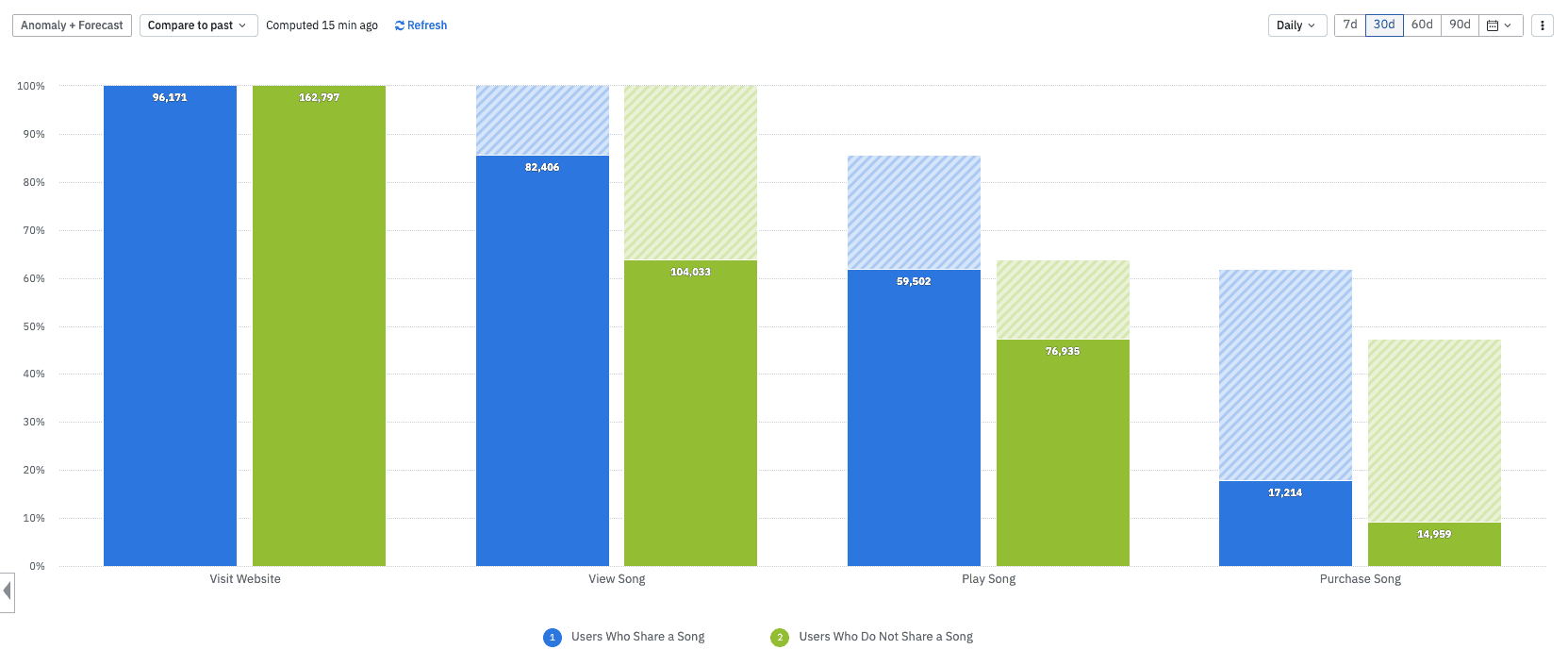Customer Funnel: Convert Top-of-Funnel Users to Customers
Learn about the different stages of the customer funnel and get tips for nurturing customers from awareness to purchase.
A customer funnel is a visual depiction of a customer’s steps from becoming aware of a product or service to converting into a paying customer.
Typically, the funnel looks like an inverted pyramid split into stages, starting with the broadest part at the top and becoming narrower as clients move down the funnel. The top represents potential customers, while the bottom represents customers who’ve already gone through the buyer’s journey and made a purchase.
Key takeaways
- The software as a service (SaaS) customer funnel is a visualization of your customer’s journey and consists of three main stages—top of the funnel (ToFu), middle of the funnel (MoFu), and bottom of the funnel (BoFu).
- Customer funnel analysis highlights the main events in your sales process that lead customers to purchase. Analyzing your funnel also highlights obstacles and pain points that might be causing your customers to churn.
- The best marketing and sales funnels don’t treat customer purchase as the finish line. Instead, they include customer retention and advocacy stages and incorporate strategies to get loyal customers to make repeat purchases.
Stages of the SaaS customer funnel

SaaS funnels can vary depending on the simplicity or complexity of your customer journey. People also sometimes refer to customer funnels as marketing, sales, conversion, purchase, lead, or customer journey funnels. While each funnel type is distinct, they all represent how a prospective customer turns into a paying customer.
Consider adopting a one-funnel approach that encompasses marketing campaigns and sales activities and helps visualize your entire customer journey. This funnel consists of three simple stages:
- ToFu: Top of funnel
- MoFu: Middle of funnel
- BoFu: Bottom of funnel
ToFu: The awareness stage
ToFu is the first stage in the marketing or sales funnel, during which your customer is in the awareness stage. ToFu prospects represent a wide, cold audience, most of which won’t immediately require your products or services.
This stage is research-driven as prospects realize they have a problem and search for possible solutions. They may not know your brand yet or what products can solve their needs yet.
ToFu content to raise brand awareness
During this stage, your goal is lead generation. One way you can do this is by offering entertaining or educational content that positions your product as a potential solution and introduces your brand as a valuable resource. Below are some of the most effective content types to get your company on the radar and build awareness about your products.
- Display ads appear on webpages and articles your prospects view, often with the “sponsored content” tag. The best display ads have an engaging heading that links the ad to top-of-funnel content—like a blog post—to get customers to click on the ad.
- Social media ads use social networks like Instagram, Facebook, LinkedIn, TikTok, and Twitter to deliver paid advertising to your target ToFu audience. Social media and pay-per-click (PPC) ads can help you connect to different customer personas by offering a wide range of targeting options. These include demographics, age groups, interests, working titles, etc.
- Influencer partner content entails partnering with an influencer or industry expert for product endorsement or advertising. Since these influencers have an established following and may already have your target audience’s attention, it’s a great ToFu content type to consider.
- Overview blogs use search engine optimization (SEO) to target keywords with high search volume and generate organic traffic to your website beyond your landing page. Overview blogs are a vital part of your content marketing strategy. They help your potential customers realize their problems at the ToFu stage and position your product as a possible solution to the problem.
MoFu: The engagement stage
MoFu is a smaller, more qualified portion of your audience. In this middle stage of the SaaS funnel, users have clearly identified their problems and narrowed their list of possible solutions. If you’ve done a solid job at the ToFu stage, the user may be starting to see your product as a potential option.
During the MoFu stage, your audience actively compares your solution to other alternatives. Your job is to explain what makes your brand trustworthy and differentiate your products from the competition. Consider using MoFu content to help your audience work through potential evaluation questions and provide the information required to move into the decision stage of the funnel.
MoFu content to foster customer relationships
- Email marketing campaigns help you connect with your email list subscribers and nurture them to conversion. Successful email campaigns use eye-catching headings and relevant content with clear calls to action (CTAs).
- Product comparisons illustrate how your product’s features, capabilities, and pricing differentiate from the competition.
- Case studies help customers see your solution in action by showcasing benefits and measurable results it’s delivered to other companies.
- Customer testimonials are recommendations from satisfied customers that confirm the value of your product.
BoFu: The decision stage
Your bottom-of-the-funnel leads are highly qualified and represent your smallest—yet most profitable—slice of your target audience. BoFu customers are well on their way to buying your product but may need a little extra incentive to purchase.
BoFu content to boost your conversion rate
Your main objective is to provide your BoFu leads with sufficient proof that your product is the absolute best for their needs and will deliver their desired outcomes. The best BoFu content includes high-value assets, hands-on experiences, and incentives for customers to close the deal.
These content types should be reserved for the bottom of the funnel to ensure your prospects are highly qualified. That’s because they typically require more resources from your organization and contain information you don’t want falling into the hands of your competition.
- Free trials enable customers to try your product for free and decide if they like it enough to invest in the paid version.
- Demos and video tutorials showcase your product’s capabilities and provide step-by-step instructions for getting started. Many organizations offer these alongside useful webinars and infographics.
- Giveaways or promotions can help sway customers who are on the fence about purchasing.
- Consultations, virtual and in-person, offer an excellent opportunity to meet your customers and discuss how your product can solve their needs. It’s crucial that sales teams deliver a five-star customer experience during consultations and clearly communicate your product’s benefits over alternatives.

An example sales funnel for a music-streaming app with stages showing conversion.
How Customer Funnels Have Evolved Over Time
Before mass and digital marketing emerged, customer funnels were narrow and considered “sales only.” To convince a customer to buy a product, you had to have a sales conversation with them. Salespeople were the primary information source for prospects about products and delivered highly personalized experiences. However, this approach had serious shortcomings—it was time-intensive and expensive to acquire a single customer.
In 1898, famous advertiser Elias St. Elmo Lewis developed the AIDA model, describing the four stages a customer undergoes before purchasing. The AIDA framework traces the customer’s journey through awareness, interest, desire, and action stages.

The AIDA model is still relevant and remains at the core of modern sales and marketing funnels. The following are some of its most common variations:
The marketing funnel
• Awareness: How do customers become aware of your product?
• Interest: How many customers show interest in your product?
• Consideration: How many customers consider purchasing your product?
• Intent: How many customers intend to purchase your product?
• Evaluation: How many customers compare your product to others?
• Purchase: How many customers purchase your product?
The AAARRR or the Pirate Funnel
• Awareness: How many customers become aware of your product?
• Acquisition: How many customers visit your website?
• Activation: How many customers take the first step to conversion? This includes steps like registering, signing up, or installing your app.
• Retention: How many customers make repeat purchases?
• Revenue: How many customers have started paying?
• Referral: How many customers refer others to your business?
How to conduct a customer funnel analysis that delivers actionable results
Conducting a funnel analysis is the best way to understand what events lead customers to conversion. Funnel analyses highlight the key events in your customer journey that are most likely to trigger a purchase and help identify obstacles that might cause customer churn. Analyzing and improving your customer funnel is also helpful in understanding and optimizing the efficiency of your marketing and sales efforts.
To conduct a customer funnel analysis, start by charting your customer’s typical buying process. Use customer journey maps to visualize every step your customer takes, from first awareness of your product to purchase.
Once you’ve charted the buying process, decide which KPIs to track along the customer’s journey. Consider using metrics like lead development, time to convert, lead churn, and customer lifetime value (CLV).
Finally, examine and identify bottlenecks and drop-off points throughout your SaaS customer funnel. Amplitude’s funnel analysis chart helps you understand how users navigate defined paths within your product and identify potential problem areas where users tend to drop off.

Funnel analysis example in Amplitude
If you want to drill further into your sales funnel, you can also look at subsets of your funnels based on different segments or cohorts. A cohort is a group or segment of users who share common profile traits, demographics, or behaviors. Cohort analysis breaks down the actions of these users at every stage of the conversion path.

Behavioral Cohort Comparison in Amplitude
What happens when a customer gets through all the funnel stages?
The SaaS funnel helps convert your top-of-funnel prospects into paying customers through a guided process. However, your relationship with the customer doesn’t end after the first purchase, especially in the SaaS landscape. Did you know 82% of businesses agree that retaining customers is less expensive than acquiring new ones? So, your goal is to turn new customers into repeat customers and brand advocates.
Here are some customer retention tips:
• Define your product’s critical event or aha moment and encourage customers to complete it
• Educate your customers to increase product adoption
• Create loyalty and referral programs
• Offer discounts and incentives
• Collect qualitative feedback
By directing your sales and marketing efforts toward customer retention, you can significantly boost your brand’s revenue and profits.
Move more prospects down the funnel with Amplitude
The highest-performing SaaS companies have a healthy customer funnel across all three stages and realize that feeding the funnel is a continuous process. They also understand that effectively nurturing customers through the MoFu and BoFu stages using the right tactics and content is equally important—and that analytics can help them do so.
Amplitude makes it easy to visualize, measure, and understand key user behaviors throughout the customer journey. Our funnel analysis product is built for websites and products, giving a more holistic perspective on data.
You can track any event or user behavior, not just page views or sessions. When conducting funnel analysis in Amplitude, you can order the events of your funnel, segment behavioral cohorts, and set specific conversion windows.
Want to see for yourself? Get a demo.

Darshil Gandhi
Director, Product Marketing, Amplitude
Darshil Gandhi is a Director of Product Marketing at Amplitude. He leads global technical and partner product marketing, collaborates with product and go-to-market teams on strategy, positioning, messaging, campaigns, and enablement. He was previously a solutions consulting team principal at Amplitude, and has helped dozens of Amplitude customers turn their data into actionable insights. Darshil graduated from Dartmouth College with a Masters in Engineering Management.
More from Darshil




